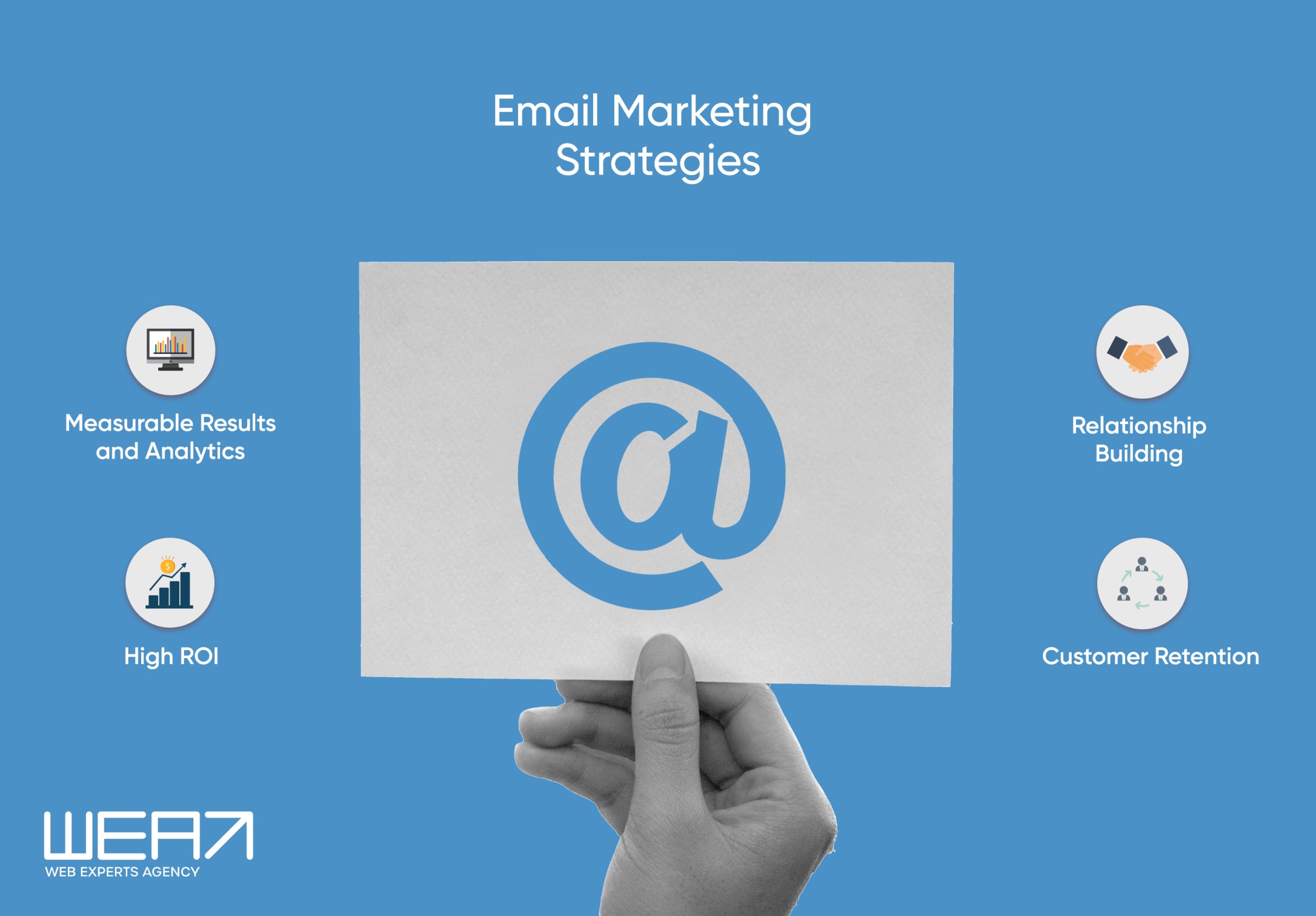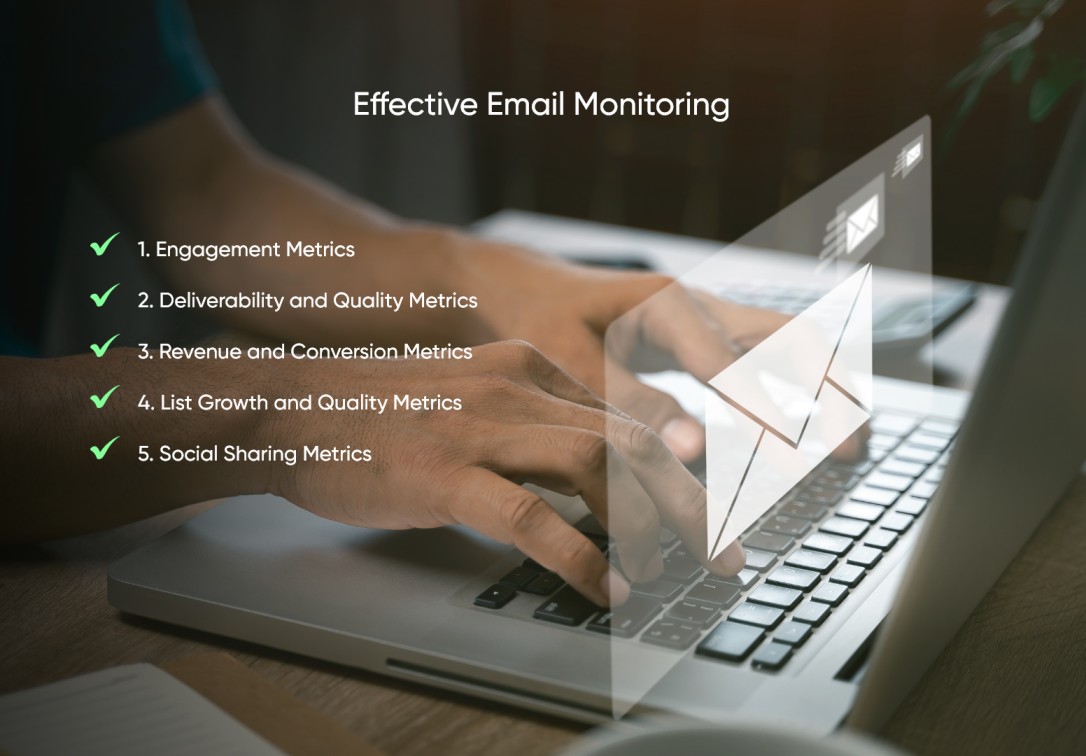
Email marketing is an essential part of the digital marketing strategy that involves sending focussed emails to a target group of recipients to promote products, services, offers, or build relationships. It’s a highly effective way to engage with customers, nurture leads, and drive conversions. Email marketing campaigns can include newsletters, promotional emails, transactional emails, and more.
Ways to track your email marketing activities
Tracking key metrics and KPIs (Key Performance Indicators) in email marketing is essential for evaluating the effectiveness of your campaigns.
Here’s a comprehensive list of email marketing analytics metrics and KPIs you should be tracking:
1. Engagement Metrics:
These are the toplined metrics that indicate the effectiveness of your emails for engagement based on their relevance. As the benchmark rates of these metrics vary according to the industry that the mail belongs to, you must not be discouraged by ambiguous targets and know your industry standards.
-
Open Rate:
This is the percentage of recipients who opened the email.
-
Click-Through Rate (CTR):
This is the percentage of recipients who have clicked on a link within the email you sent.
-
Click-to-Open Rate (CTOR):
This is the percentage of recipients who have clicked on a link after they opened the email you sent.
-
Conversion Rate:
This is the percentage of recipients who took a desired action (e.g., purchase) after clicking a link.
-
Bounce Rate:
This is the percentage of emails that failed to deliver due to various issues. Most industries consider an up to 2% bounce rate within limits.
2. Deliverability and Quality Metrics:
These are the stage 2 KPIs crucial for any email marketing campaign’s success.
-
Inbox Placement Rate:
This is the percentage of emails that successfully reach recipients’ inboxes.
-
Spam Complaint Rate:
This is the number of spam complaints as a percentage of total recipients.
-
Unsubscribe Rate:
This is the percentage of the recipients who unsubscribed after receiving the email.
3. Revenue and Conversion Metrics:
These metrics matter for a business, as no business can run without money.
-
Revenue Generated:
This is the total revenue attributed to the email campaign.
-
Average Order Value:
This is the average value of orders resulting from the email.
-
Return on Investment (ROI):
This is the revenue generated from a campaign compared to the cost of running that campaign.
4. List Growth and Quality Metrics:
As a business establishes its presence, it matters how it develops its target group and grows further.
-
List Growth Rate:
This is the rate at which your email list is growing.
-
List Churn Rate:
The percentage of subscribers who leave your list over time.
-
List Growth by Source:
This helps identify which sources contribute the most to list growth.
5. Engagement by Device and Platform:
In this digital age, customers use many different devices and gadgets, which may affect their perceived impact of emails. Insights into these metrics help tweak the design and readability of the emails for tremendous success.
-
Mobile Open Rate:
This is the percentage of emails opened on mobile devices.
-
Desktop Open Rate:
This is the percentage of emails opened on desktop devices.
-
Engagement by Email Client:
This helps know which email clients and platforms recipients use.
6. Segmentation and Personalization Metrics:
The need for personalization was never more than in the current digital era. Segmentation is a good attempt at starting to provide that custom experience.
-
Engagement by Segment:
This helps identify how different segments of your list respond to campaigns.
-
Personalization Effectiveness:
This measures the impact of personalized content on engagement.
7. Social Sharing Metrics:
If it’s good, it should be shared on social media platforms. Whether catching on a trend or starting one, trends are all the buzz these days.
-
Social Sharing Rate:
This is the percentage of recipients who share the email on social media.
-
Forward Rate:
This is how often recipients forward the email to others.
8. Click Heatmaps and Path Analysis:
Recording customer journeys gives clear insights into their experience with the brand and its digital media.
-
Heatmaps:
This visual represents where recipients clicked within the email.
-
Conversion Path Analysis:
This analyzes the user journey from email click to conversion.
9. Unengaged Subscribers Metrics:
Although winning back lost customers/users is exceptionally challenging if you can identify the reasons for the loss, the path gets simpler.
-
Inactive Subscribers:
This identifies subscribers who haven’t engaged with your emails in a certain period.
-
Re-engagement Rate:
This is the percentage of inactive subscribers who re-engage with your content.
10. Time-Based Metrics:
Timing is important. Moment marketing is a big hype nowadays, and getting on that bandwagon is any marketer’s birthright.
-
Best Sending Time:
This determines when your emails receive the highest engagement.
-
Time of Day Analysis:
This analyses which times of day recipients are most active.
Each metric provides valuable insights into various aspects of your email marketing campaigns. Tracking and analyzing these metrics can help you refine your strategies, optimize content, and achieve better results over time.

How do you calculate the critical email marketing performance metrics?
While there are so many metrics, as discussed above, which can help you build and retain your customer base, the following are some of the most widely used metrics with their respective calculations:
-
ROI (Return on Investment)
ROI measures how profitable an email marketing campaign is. It compares the generated revenue in the campaign with the costs incurred. A positive ROI indicates a successful campaign.
Calculation:
(Revenue – Cost) / Cost
-
Conversion Rate
The conversion rate measures the number of recipients who took a desired action (e.g., purchasing) after receiving the email. A higher conversion rate indicates that the email was effective in driving action.
Calculation:
(Number of Conversions / Total Number of Recipients) * 100
-
CPA (Cost Per Acquisition)
This metric measures the costs of acquiring a customer through email marketing. Lowering the CPA while maintaining quality helps improve campaign efficiency.
Calculation:
Total Cost of Campaign / Number of Customers Acquired
-
CTR (Click-Through Rate)
Analyze the CTR to determine the effectiveness of your email’s content and call-to-action. A higher CTR indicates that recipients are engaged and taking action.
Calculation:
(Total Clicks / Total Opens) * 100
-
Unsubscribe Rate
Monitor the unsubscribe rate to gauge whether your emails are providing value. High unsubscribe rates might indicate that recipients find your content irrelevant or excessive.
Calculation:
(Number of Unsubscribes / Total Number of Recipients) * 100
CLV (Customer Lifetime Value)
CLV is calculated based on a customer’s historical behavior and spending patterns. It can be impacted by email campaigns that encourage repeat purchases and customer retention.
Make your email marketing performance analysis easier with these tips.
By following these tips, you can streamline your email marketing performance analysis, gain actionable insights, and make decisions backed with data to optimize your campaigns for greater success.
-
Email Service Provider (ESP) Analytics:
Most email marketing platforms provide actionable insights into various metrics through built-in analytics tools. ESP analytics allow you to monitor the performance of your campaigns in real-time. Use email marketing platforms (e.g., MailChimp, HubSpot, etc.) that provide analytics dashboards to track key metrics.
-
Segmentation:
Segmenting your email list based on factors such as demographics, behavior, purchase history, and engagement levels helps analyze how different segments respond to campaigns. This allows you to tailor future messages for better results.
-
A/B Testing:
Conduct A/B tests by sending variations of emails to different segments and measuring which version performs better. Test subject lines, content, call-to-action buttons, and other elements. The statistical significance of this testing is to determine if test results are reliable or due to chance.
-
Conversion Tracking:
Use tracking links or pixels to monitor conversions. Analyze which emails or campaigns led to the most conversions and adjust your strategies accordingly.
-
Comparative Analysis:
Compare metrics across different campaigns to identify trends and patterns. Understand what works and what doesn’t, and iterate based on insights.
Regularly analyzing performance metrics allows you to optimize your email marketing strategies, refine your content, and achieve better results over time.

Importance of Email Marketing Campaigns
Email marketing is important for numerous reasons, as it offers wide-ranging benefits to businesses and organizations of all sizes.
-
High ROI (Return on Investment):
Email marketing consistently ranks among the most cost-effective digital marketing channels. It offers a high ROI due to its relatively low costs and potential for generating significant revenue through conversions.
-
Audience Reach and Engagement:
Email is widely used, and most individuals have an email address. You can have a direct line to your audience by building an email list, enabling you to engage with them regularly and consistently.
-
Drive Conversions and Sales:
Email is a powerful tool for driving conversions. You can include compelling calls to action, showcase products, and offer exclusive deals encouraging recipients to act.
-
Relationship Building and Brand Loyalty:
Consistent communication through email helps build a stronger relationship with your audience. Regular updates, informative content, and personalized offers contribute to increased brand loyalty.
-
Measurable Results and Analytics:
Email marketing provides detailed analytics to track open rates, click-through rates, conversions, and more. These insights allow you to refine your strategies based on data-driven decisions.
-
Customer Retention and Repeat Business:
Emails can keep your brand top-of-mind with customers. You can encourage repeat purchases and customer loyalty by providing value, offering promotions, and staying in touch.
-
Easy to Share and Forward:
Recipients can easily forward emails to friends and family, increasing your brand’s reach through word-of-mouth marketing.
-
Opt-in and Permission-Based:
Email marketing relies on recipients opting in for communications. This means you’re communicating with an audience that has expressed interest, leading to higher engagement rates.
To conclude, email marketing is a versatile and essential strategy that offers a direct and personalized way to connect with your audience, drive conversions, and build lasting relationships. Its cost-effectiveness, scalability, and potential for high ROI make it a valuable asset for businesses across industries.
FAQs
Q. Is email automation an effective marketing strategy?
A. Email marketing automation is a powerful strategy that allows you to streamline your campaigns, improve efficiency, and deliver more relevant and personalized content to your audience.
Q. Is there a need to stay updated about email marketing techniques?
A. How successful brands measure their marketing campaigns has changed over the years, which calls for always being on top of the email marketing game.
Q. Is targeted marketing effective?
A. Segmentation helps divide your email list into specific groups that are more likely to be your customers. This precision targeting ensures that your messages are relevant and resonate with recipients.
Q. How do you define an automation strategy for your emails?
A. Email marketing platforms offer automation features that streamline campaign management. You can start by setting up automated emails for welcome sequences, abandoned cart reminders, and more, saving time and effort.
Q. Should you integrate email marketing into your overall marketing strategy?
A. Email marketing can complement and integrate with other content marketing channels, creating a cohesive and effective marketing strategy.




